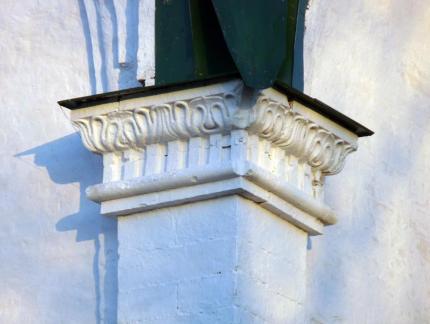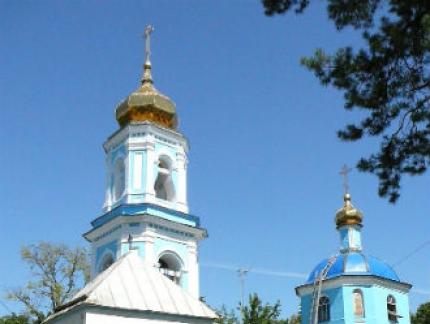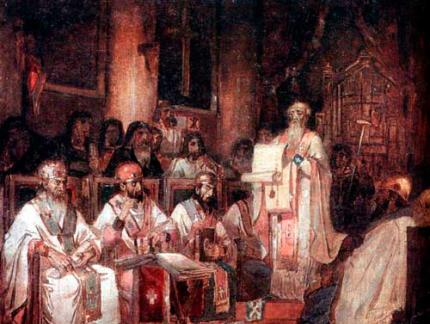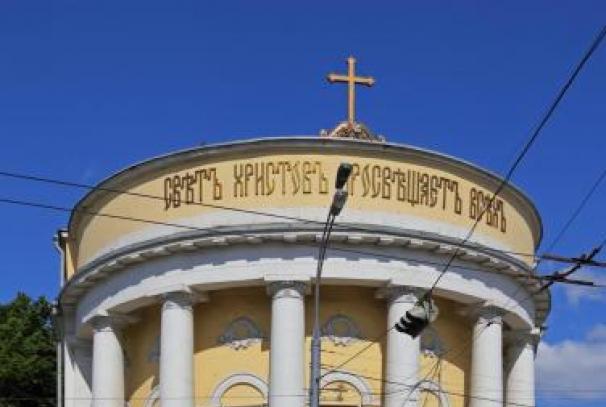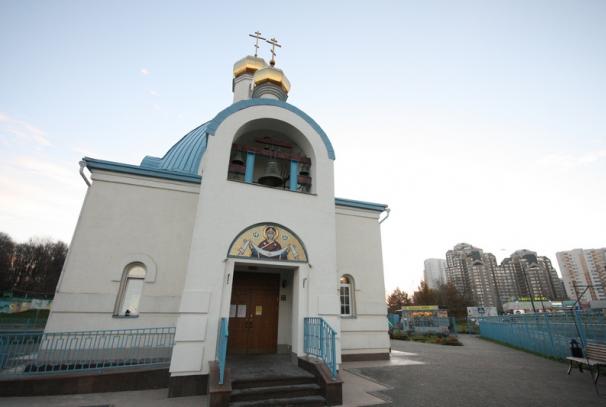Church of the Holy Trinity Church of the Life-Giving Trinity in Sviblovo


2016 Easter
 The Church of the Life-Giving Trinity is located on the territory of Sviblovo Manor, which is located on the high bank of the Yauza.
The Church of the Life-Giving Trinity is located on the territory of Sviblovo Manor, which is located on the high bank of the Yauza.
The first documented mention of Sviblovo dates back to 1432.
In the spiritual letter of Moscow Prince Vasily the first, Sviblovo is called "the village of Fedorovsky on the Yauza with a mill." According to the legend, it was obliged by this name to the neighbor boyar of Dmitry Donskoy Fyodor Semenovich Sviblu. A wooden church was built here, but in the Time of Troubles, Sviblovo lost it. The estate was granted to Lev Afanasevich Plescheev in the hereditary possession for the defense of Moscow from foreign troops. The name of Moscow Governor Kirill Naryshkin was associated with Sviblov. He created an excellently staged serf theater, which was visited by Catherine the Second, and since the local peasants were famous for playing the wind instruments, he organized an orchestra of horn music.
It is also known that Empress Anna Ioannovna sent a special courier to Sviblovo: to find peasants who play the flute well for her court orchestra.

At the same time, Naryshkin was actively rebuilding Sviblovo: he remodeled the old Plescheevsky chambers that have survived to this day, erected the stone church of the Holy Trinity in 1708, and a year later, built a bell tower near it. The memory of the Peter the Great remained on it a captured Swedish bell. The ensemble of the Sviblovskaya Church represents one of the most interesting architectural monuments of the Moscow Naryshkinsky Baroque.
With the death of Kirill Naryshkin, Sviblovo is returned to the Pleshcheevs. And in 1745 for a relatively short time it was transferred to the possession of the Golitsyn family. A little later Sviblovo, together with the neighboring villages Kazeev and Leonov, is acquired by the family of the merchant Kozhevnikov.
After the October Revolution of 1917, the temple was closed, beheaded and underwent significant destruction, the territory of the Estate turned into a landfill for construction waste in the north-east of Moscow.
Only in 1994, the desecrated and desecrated shrine and four historical buildings of the Manor complex were transferred to the Russian Orthodox Church.

Day after day by the creative work of pious parishioners, the Manor acquired its former appearance, former grandeur - a testament to the faith and love of the Russian people for Heavenly and Earthly Fatherland.
Now the temple of the Trinity Life-giving has the status of the Patriarchal Compound. In 2008, the temple celebrated the 300th anniversary of the consecration.
Rector of the Temple - Dean of the Temples of the Trinity (now Sergievsky) District of Moscow, Archpriest Sergiy Kiselev.

On the picturesque shore of Yauza, the Sviblovo estate with the Holy Trinity Church has survived to this day.
For centuries, this place has been owned by servants of the great princes of Moscow and Russian tsars.
The history of the Sviblovo district has its roots in the distant XIV century. Researchers suggest that the name of the district comes from the name of the first governor, Prince Dmitry Donskoy, boyar Fedor Andreevich Svibly, who founded the settlement here and built a wooden church, but in the Time of Troubles, Sviblovo lost it.
By 1620, Sviblov was owned by the steward Lev Afanasevich Pleshcheev. It was a generous reward for participating in the defense of the capital from the Polish-Lithuanian troops, granted by the sovereign Mikhail Fedorovich, the first of the Romanovs, recently elected to the Russian throne.
In 1677, Pleshcheyev transferred his village to his son Andrei, who was actively engaged in agriculture, rebuilt the wooden Trinity Church and attached to it the chapel of St. Alexis, Metropolitan of Moscow.
From the Plescheev family, the last owner of the family estate was the young girl Mary, who lived in the house of her uncle Kirill Alekseevich Naryshkin. After the death of the girl, the ownership of Sviblovo passes to him. Moscow Governor Kirill Naryshkin built stone chambers, a malt factory, a cookery, and human chambers in his estate from solid brick. In 1708, the existing stone building of the Temple was built, and a year later it erects a bell tower near it. Captive Swedes were involved in these works. One of the bells of the Trinity Church, which rang throughout the district, was a captured Swedish, brought from the Northern War. The ensemble of the Sviblovskaya Church represents one of the most interesting architectural monuments of the Moscow Naryshkinsky Baroque.
With the death of Kirill Alekseevich Naryshkin, Sviblovo is returned to the Plescheev family.
In 1745, for a relatively short time, it was transferred to the possession of the Golitsyn family.
At the beginning of the 19th century, the great Russian writer and historiographer Nikolai Mikhailovich Karamzin lived in the estate. Here in once such picturesque places on the banks of the Yauza near Karamzin, perhaps the idea arises of writing a monumental work on the history of the Russian state. The childhood of the great Russian composer A.N. Scriabin was also associated with Sviblov.
In the 20s of the XIX century, the merchant I.P. bought Sviblovo Tanners. At that time, guests often came to the estate to listen to invited artists. Kozhevnikov is building a manor house and an exemplary cloth factory working on imported equipment. Launched in 1821, it was the first large industrial enterprise in our area and at that time was an extraordinary novelty. Exemplary production received such loud fame that it attracted the attention of the reigning persons - Empress Maria Fedorovna and Emperor Alexander I.
After the October Revolution of 1917, the temple was closed, beheaded and underwent significant destruction, the estate turned into a landfill for construction waste in the north-east of Moscow.
In 1938, the temple was used as a utility room.
New time has made it possible to begin the restoration of the dilapidated building of the Temple. In 1994, His Holiness Patriarch Alexy II of Moscow and All Russia decided to create the Sviblovsky Patriarchal Metochion, Archpriest Sergius was appointed rector of it.
The name of this estate echoes the name of one of the towers of the Moscow Kremlin - Sviblova, also known as Vodovzvodnaya. Such a connection is not accidental: boyar Fedor Andreevich Sviblo, who occupied a high position in the 14th century under Prince Dmitry Donskoy, owned not only the chambers in the Kremlin near the tower that received his name, but also a picturesque village on the banks of the Yauza River. Most likely, the first wooden church in the name of the Trinity of Life-giving appeared here with him.
Soon after the death of Prince Dmitry Donskoy, the Sviblovs fell into disgrace and their possessions were transferred to the treasury. Only in the 1620s did the village again become private property, passing into the hands of the stolnik Lev Pleshcheev. His son, Andrei Lvovich, built a new wooden church of the Trinity in 1622–1623 to replace the church that had burnt down during the Time of Troubles. The next restructuring dates back to 1677, carried out by her second son Pleshcheyev - Mikhail Lvovich. In 1704, after the death of a young orphan, Marya Plescheeva, the village passed to her teacher, Kirill Alekseevich Naryshkin. Under him, possession not only received new residents in the form of captured Swedes brought from the Northern War, but also significantly changed its appearance: new stone chambers, a cookhouse, a human wing, a malt factory appeared, and in 1708 a stone church of the Trinity Zhivonachalnaya was built.
The architecture of the church is heterogeneous, as if located "on the border." In the lower tier, one can still feel the influence of the “Naryshkin Baroque” with its “torn pediments” on the window frames and triple beams of columns at the corners. At the same time, the middle and upper tiers are already built in the style of "Peter's Baroque", which is closer to European motifs. The general elongation of the church vertically, the structure "octagon on four", some "geometricity" of the middle and upper tiers, triple arched windows - all this is more characteristic of a new direction in church architecture. In Moscow, the Menshikov Tower near Chistye Prudy can serve as an analogue. In 1709, the chapel of St. George was added from the north. Initially, the bell tower existed separately, but at the end of the XVIII century it was dilapidated and was dismantled, after which the existing bell tower, built in the classical style, was added to the temple from the western side.
In 1721, the estate returned to the Plescheev family, then it passed into the hands of the Golitsins, Vysotsky, Kazeevs, Kozhevnikovs, and Halatovs. At the beginning of the 19th century, the famous Russian historian and writer N.M. lived in Sviblovo. Karamzin, his wife died here. The next owner, the merchant Kozhevnikov, built a cloth factory next door. By the beginning of the twentieth century, Sviblovo was actively inhabited by summer residents, many of whom visited the Trinity Church and took care of its condition. So, in 1905, it was re-painted at the expense of the summer resident Agrippina Kuzmina.
After the revolution, the estate was occupied by the local revolutionary committee, and then transferred to housing for railroad workers, which remained here until the 1970s. Trinity Church was opened until 1938, after which it was owned by various offices. In this case, the historic interiors were completely destroyed, the heads of the church and the bell tower were cut down, and the refectory was built on. At the same time, the building was armed in the 1970s as a monument of architecture, but with an error: in the documents it was listed as the “Church of the Assumption”. In the 1980s, a full-scale restoration of the entire estate began, during which work was carried out on the main house of the Baroque era and the church, and the outbuildings and services were recreated. In 1995, the first service was held in the Trinity Church, and soon the whole place received the status of the patriarchal courtyard of the Russian Orthodox Church.
At the very beginning of the XVIII century Sviblovo went to the relative of Peter I from the mother’s side, Kirill Alekseevich Naryshkin. Under him, in 1708, a one-domed church was built of brick and white stone. A year later, the bell tower appeared, which received one of Peter's trophies - the Swedish bell. Stone chambers and a malt factory were also built. After the Battle of Poltava, Naryshkin took his people to other estates, and settled the captured Swedes, “all kinds of artisans” in Sviblov. After some time, as a result of the trial, the estate again departed Plescheev. At different times, the owners of the Sviblovo estate were also the Golitsins, Kazeevs, Kozhevnikovs. From the 70s of the 19th century until the October events of 1917, the estate belonged to mining engineer Georgy Bakhtiyarovich Khalatov.
In Soviet times, the estates and the temple slowly fell into decay. Currently, the estate is being restored in the form of the Patriarchal Compound of the Russian Orthodox Church, services are being held in the church.
Trinity Church in Sviblovo (Lazorevy proezd, building number 15).
In 1677, in the village of Sviblovo (known since the XIV century as the estate of the boyar and governors Fedor Andreevich Sviblo), a wooden church was built in honor of the Life-Giving Trinity with an aisle of St. Alexy, Metropolitan of Moscow. The stone church of the Holy Trinity with the chapel of the Great Martyr George the Victorious appeared at the beginning of the XVIII century. In it, the forms of the Naryshkin Baroque were combined with the techniques of the new order architecture of the Petrine era, nicknamed the “Dutch architectural taste”. The temple is tiered, in the form of a cruciform, single-headed. The decorative details of the platbands of windows and porticoes of the lower tier are made back in the tradition of the 17th century, as well as the St. George chapel attached to a separate volume. The middle tier in its appearance sharply contrasts with the lower, there is nothing from the architectural elements of the XVII century. A significant role in the decoration is played by a parapet with curly balusters crowning the volume of the main quad. The three-part arched window of the quadrangle is close in shape to Western European patterns. The upper tier - an octagon and a similar drum - again remind of the Moscow tradition.
At the turn of the 18th-19th centuries, a manor house was erected in the estate with wings, which partially survived to our time. At the same time, a new two-tier bell tower was added to the Trinity Church, the lower tier of which is the entrance to the temple, and the upper tier is an open bell. With the decline of the estate in the 2nd half of the 19th century, the church also became desolate, and services are rarely held there. In 1905, they reconstructed the decoration of the church building.
In 1938 the church was closed, beheaded, and the interior was destroyed. The building was occupied by production workshops. In April 1995, divine services resumed. Currently, the temple has been restored and has the status of the Patriarchal Compound. His shrines are especially revered icons of the Mother of God "Iverskaya" and "Merciful."
Mikhail Vostryshev "Moscow is Orthodox. All temples and chapels." http://iknigi.net/avtor-mihail-vostryshev/
Church in the name of St. Trinity, which existed in the XVI century. in the village of Sviblovo, it was probably destroyed at the beginning of the XVII century. in Lithuanian troubled times. In the scribal books of 1623-24. it is written: “behind the steward Andrei Plescheev in the patrimony that his father Lev Plescheev gave him, and his father Leo that patrimony was given for the Moscow siege seat of the royal parish, the village of Sviblovo, on the Yauza River, and there was a church in it in the name of the Life-Giving Trinity, yes there are four places in the church land: priestly, clerk, ponomarevo, and moss; arable land church lands of 20 quarters in the field, hay on the Yauza River 10 kopecks; in the village there is a court yard of patriots, business people live, 2 courtyards of human backyards; And the plowman Andrei Plescheev plows the church land. "
In 1658, his brother Mikhail Pleshcheyev owned the village, during which a new wooden church was built in the village of Sviblovo around 1677 in the name of the Life-Giving Trinity with an aisle of St. Alexei Metropolitan and lined with tribute. In census books of 1678 it reads: “behind the steward Mikhail Lvovich Pleshcheyev in the patrimony of the village of Sviblovo, on the Yauza River, and in the village of the Church of the Life-Giving Trinity, yes the chapel of Alexei Metropolitan, the church in the courtyard of the priest Jacob, in the courtyard of the clerk Vorfolomeyko, and in the village the patriarch’s yard and the livestock yard, they have 9 families of business people, 4 courtyards of grooms and 4 courtyards of cooks, 11 of them are people. ” In 1680, there was no priest at the church.
After M. L. Plescheev, the village of Sviblovo went to his native nephews Semyon and Fedor Fedorovich Plescheev; in 1702 it belonged to the daughter of Semen Fedorovich Pleshcheyev, the girl Marya, and from her passed to her uncle Kirill Alekseevich Naryshkin, after which it was approved in 1704 by a refusal book: “refused to Kravchik Kirill Alekseevich Naryshkin, the niece of his damsel Maryina Semyenyevna, who is the niece of his maiden Maryyenevna Semeyenyna hereinaevna Semenyevna Semyeenyevna Semyeenyevna Semeyenyevna that he, Kirill Alekseevich, in 1704, according to a personal order of the great sovereign and testament of her maiden Mary’s will, to interrogate the father of her spiritual Annunciation Cathedral, which was in the Upper Seny, the foreman Ivan Afanasyev, in the Moscow district, in Manat I will become the village of Sviblovo, on the Yauza River, in Byin and Korovin, and in it there is a church in the name of the Life-Giving Trinity, and in the name of Metropolitan Aleksei the chapel is old, kletsky, and in the same village of Sviblovo the courtyard of the estate men with every courtyard and mansion and garden, and every factory, and in the courtyard of courtyards and business people there are 6 people, 4 courtyards of courtyards and 3 courtyards of courtyards, there are 14 people in them. ”
In the village of Sviblovo in 1708, a stone church of St. Trinity, and on the day of the consecration of the same year, December 24, "by blessed deed, an antimins was issued to the newly-built church of the Life-Giving Trinity, and the antimins was taken by the priest Jacob Ioannov." Under 1709 it reads: “in the village of Sviblovo, the Church of the Life-Giving Trinity with the side chapel of St. vmch George stone, at the church in the courtyard, Philip Leontyev, serves annual service, the court of the estate (Kirill Naryshkin), and according to the tale of the headman Fedot Timofeev, people were taken out of the boyars and backyards to different estates and all kinds of craftsmen live in those yards people".
In 1721, according to the decision of the Justits College, as a result of the petition of Ivan Dmitrievich Plescheev, the village of Sviblovo, owned by Kirill Alekseevich Naryshkin, was returned to the Plescheev family, and the same year it was approved by him, Ivan Plescheev, a rejected book: “refused the stolnik Ivan Dmitrievich Plescheev, his close relative, the maiden Marya Semenovna Plescheeva, in the Moscow district, the village of Sviblovo, and in that village of God church in the name of St. Trinity, and the chapel of the great martyr George, a stone and stone bell tower with bells, chambers and cellars, and a cookhouse, and human chambers, and a stone malt plant, light rooms and a stable yard, human chambers and wooden barns; a mill on the Yauza River about four stands, a miller’s yard, and two foreigners live in it, and there are 4 fish ponds in the same village. ”
Upon the death of I.D. Pleshcheyev, this village passed in 1728 to his son Semyon with his widowed mother Anna Dorofeevna Plescheeva, who married Prince Peter Yakovlevich Golitsyn with this estate. The Trinity Church in the village of Sviblovo was written under the Seleck tithe, according to the arrival books of the Patriarchal Public Administration, for 1678-89. "In the estate of the steward Mikhail Plescheev", and in 1690-1740. “In the patrimony of the stolniks Semyon and Fyodor Fedorovich Pleshcheev,” with the designation of a tribute from 1712. 39 altyn 2 money.
Kholmogorov V.I., Kholmogorov G.I. “Historical materials about churches and villages of the XVI - XVIII centuries.” Issue 4, Seletskaya tithe of the Moscow district. Edition of the Imperial Society of History and Antiquities of Russia at Moscow University. Moscow, at the University Printing House (M. Katkov), on Strastnoy Boulevard, 1885
Temple History
On the picturesque bank of the Yauza River among the blocks of new buildings, the Sviblovo estate with the Holy Trinity Church has miraculously survived to this day. For centuries, this place has been owned by servants of the great princes of Moscow and Russian tsars. From Fedor Svibla, who was in the XIV century. governor of Prince Dimitir Donskoy (his name connects the name of the estate and the name of one of the towers of the Moscow Kremlin) to the stolnik Lev Pleshcheev, who in 1620 received this estate from Tsar Mikhail Fedorovich Romanov as a reward for the "Moscow Siege Sitting". The new owners build estates on the river bank and in 1677 the Trinity Church with the aisle of St. Alexis, Metropolitan of Moscow, with whom the Plescheevs were proud. In 1708, the existing stone temple building was built. It appeared in that short but brilliant period in the history of the estate, when its prominent leader was the prominent statesman of the Moscow governor, Kirill Alekseevich Naryshkin, a relative of Tsar Peter I by mother, Natalya Kirilovna Naryshkina. The church was inscribed in the regular estate plan and became an embodiment of customer loyalty to the court "Naryshkinsky" style, which fancifully combined traditional Orthodox symbols with bold architectural and decorative techniques. The complex of buildings included; the church, the manor house, two outbuildings, a human house and a greenhouse. Here reflected the great and controversial era of the Petrine reforms, the era of the synthesis of West European and Old Russian principles, a creative dialogue of the old and the new.
Many distinguished guests visited here at different times. In the years 1801-1803, the great Russian writer and historiographer Nikolai Mikhailovich Karamzin lived in the estate, connected with Pleshcheyev family and friendly ties. Maybe it was then that he conceived "History of the Russian State." In the XIX century Sviblovo was famous for its national holidays and the well-equipped cloth factory of the merchant Kozhevnikov, which was visited with interest by Emperor Alexander 1, Empress Maria Fedorovna.
Until the beginning of the 20th century, divine services were held in this small manor church near Moscow. In 1938 the church was closed and almost until 1990 it was used as an utility room. New time has enabled believers to begin the restoration of the dilapidated temple building. In 1994, His Holiness Patriarch Alexy II of Moscow and All Russia decided to create the Sviblovsky Patriarchal Compound, whose rector was appointed Archpriest Sergius (Kiselyov), currently carrying the obedience of the Dean of the Trinity Dean of Moscow.
In ten years, much has been done. The foundation and domed masonry of the temple were strengthened, the coating of two domes, a drum, a church chapter and much more was restored. A lot remains to be done. Outside repair and restoration work continues, and inside work is underway to recreate church decoration. One of the main tasks today is the creation of the iconostasis. Unfortunately, there were no sketches, drawings or photographs that could restore its former appearance. The project of the new iconostasis, created by the architect Oskina Natalya Borisovna, focuses on the famous monuments of Russian icon painting and decorative art of the late XVII-early XVIII centuries (Church of the Intercession at Fili in Moscow). In the workshop of icon painter Nikita the Necessary, local icons are painted. Currently, work is underway on the writing of the Deesis rank icons. Ahead is the manufacture of a carved iconostasis, which in terms of the complexity of the artwork is not inferior to similar masterpieces of the past.
Much here still needs restoration and repair. The Patriarchal Compound is seeking philanthropists to finance the construction of a unique iconostasis for the Trinity Church and the restoration of the manor house of K. A. Naryshkin. The preservation of this reserved corner of Great Russia depends on the zeal of the grateful descendants.

